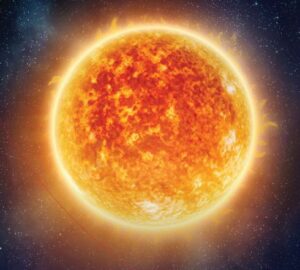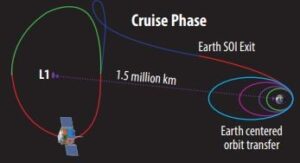The Aditya L1 mission is India’s first observatory class solar mission. It is named after Aditya, the Hindu god of the Sun. The mission is designed to study the Sun’s atmosphere and magnetic field, and to understand the processes that heat the corona and drive solar activity.
Why we need to explore Sun?
The sun is the closest star to Earth, so we can study it in much more detail than other stars. This helps us learn about stars in our galaxy and other galaxies. The sun is a very dynamic star that releases a lot of energy. It can also have explosive events that can affect Earth’s space environment. These events can damage spacecraft and communication systems. They can also be dangerous for astronauts. The sun is also a good natural laboratory for studying extreme thermal and magnetic phenomena. This helps us understand these phenomena better, even if we cannot study them directly in a lab.

Here are some specific examples of how studying the sun can help us:
- We can learn about the origin and evolution of stars.
- We can understand the processes that power stars, including nuclear fusion.
- We can learn about the magnetic fields of stars and how they interact with their environment.
- We can predict solar storms and other space weather events that can affect Earth.
- We can develop new technologies for space exploration and communication.
Studying the sun is a complex and challenging task, but it is also an essential one. The sun is our closest star, and it has a profound impact on our planet. By studying the sun, we can better understand our own place in the universe and how to protect ourselves from its harmful effects.
About Aditya L1
The Aditya L1 spacecraft will be placed in a halo orbit around the Sun-Earth L1 Lagrange point (the position in space between the Sun & the Earth where small body tends to stay), which

is located about 1.5 million kilometers from Earth. This orbit will allow the spacecraft to observe the Sun continuously without any eclipses or occultation. The spacecraft will carry sevenpayloads i.e., scientific instruments to observe the Photosphere, Chromosphere & Corona (the outmost layer of the Sun). Four payloads directly view the Sun using remote sensing and remaining three will carry out in Situ studies of particles and field at Lagrange Point L1.
Here are the seven payloads with their investigating capabilities:
Remote sensing payload
VELC (Visible Emission Line Chronograph) – Corona imaging and spectroscopy
SUIT (Solar Ultraviolet Imaging Telescope) – Imaging (narrow & broadband) photosphere and Chromosphere i.e. solar atmosphere
SoLEXS (Solar Low Energy X-ray Spectrometer) – To study Soft X-ray emission from sun (to observe the Sun as Star)
HEL1OS (High Energy L1 Orbiting Spectrometer) – To study Hard X-ray emission from sun (to observe the Sun as star)
In Situ payloads
ASPEX (Aditya Solar Wind Particle Experiment) – To analyze Protons & Heavier Ions along with directional movement
PAPA (Plasma Analyzer Package for Aditya) – To study plasma density and temperature of solar wind
Advanced Tri-axial High Resolution Digital Magnetometers – To study the magnetic field of the sun
India’s first solar mission is scheduled to launch in September 2023 and will operate for a period of five years. The mission is expected to provide valuable new insights into the Sun and its impact on the Earth’s environment.
Here are some of the key scientific objectives of the solar mission:
- To study the dynamics of the solar atmosphere, including the chromosphere and corona.
- To understand the physics of chromosphere and coronal heating.
- To investigate the origin of coronal mass ejections (CMEs) and solar flares.
- To study the in-situ particle and plasma environment at the L1 Lagrange point.
- To improve our understanding of the solar corona and its heating mechanism.
- To develop new techniques for remote sensing of the Sun.
The Aditya-L1 mission will be launched by an ISRO PSLV rocket from Sriharikota, Sathish Dhawan Space Centre SHAR (SDSC SHAR). The spacecraft will first be positioned in low Earth orbit. Following that, the orbit will be made more elliptical, and the spacecraft will be propelled using on-board propulsion towards the Lagrange point L1. As it approaches L1, the spacecraft will leave the Earth’s gravitational Sphere of Influence (SOI). After leaving SOI, the cruise phase will begin, and the spacecraft will be injected into a huge halo orbit around L1.
Aditya-L1’s entire travel time from launch to L1 would be around four months. The Aditya L1 mission is a major milestone in India’s space program. It is the first in a series of solar missions that ISRO plans to launch in the coming years. The mission is expected to make significant contributions to our understanding of the Sun and its impact on the Earth’s environment.
Key Understanding < Lagrange Points)>: For a two-body gravitational system, the Lagrange Points are the positions in space where a small object tends to stay, if put there. These

points in space for two body systems such as Sun and Earth can be used by spacecraft to remain at these positions with reduced fuel consumption. Technically at Lagrange point, the gravitational pull of the two large bodies equals the necessary centripetal force required for a small object to move with them. For two body gravitational systems, there are total five Lagrange points denoted as L1, L2, L3, L4 and L5. The Lagrange points for Sun-Earth system are shown in the figure. The Lagrange point L1 lies between Sun-Earth line. The distance of L1 from Earth is approximately 1% of the Earth-Sun distance.
